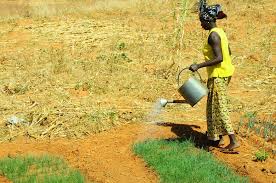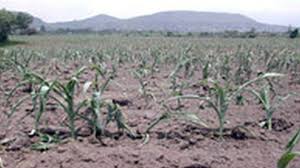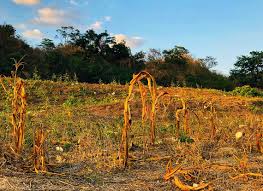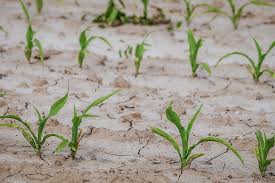In this article, desertification, its causes, effects, and spread will be studied. An example of desertification in South Africa is given because similar information from Nigeria is not readily available. The crux of the matter is how desertification can be halted or controlled. These are all spelt out in this article.
Meaning of Desertification
Desertification is the process which turns productive land into non-productive desert as a result of poor land management. Desertification occurs mainly in semi-arid areas (average annual rainfall less than 600 mm) bordering deserts. In the Sahel (the semi-arid area south of the Sahara Desert), for example, the desert moved 100 km southwards between 1950 and 1975.
Read Also: 19 Medicinal Health Benefits Of Goats Rue (Galega officinalis)
Causes of Desertification in Agriculture

1. Overgrazing: Overgrazing is the major cause of desertification worldwide. Plants of semi-arid areas are adapted to being eaten by sparsely scattered, large grazing mammals which move in response to the patchy rainfall common to these regions.
Early human pastoralists living in semi-arid areas copied this natural system. They moved their small groups of domestic animals in response to food and water availability. Such regular stock movement prevented overgrazing of the fragile plant cover.
2. Fencing Practices: In modern times, the use of fences has prevented domestic and wild animals from moving in response to food availability, and overgrazing has often resulted. However, when used correctly, fencing is a valuable tool of good veld management.
3. Boreholes and Windmills: The use of boreholes and windmills allows livestock to stay all year round in areas formerly grazed only during the rains when seasonal pans held water.
Where not correctly planned and managed, provision of drinking water has contributed to the massive advance of deserts in recent years as animals gather around waterholes and overgraze the area.
4. Cultivation of Marginal Lands: Cultivation of marginal lands, i.e., lands on which there is a high risk of crop failure and a very low economic return, for example, some parts of South Africa where maize is grown.
5. Vegetation Destruction: Destruction of vegetation in arid regions, often for fuel wood, contributes significantly.
6. Poor Grazing Management after Burning: Poor grazing management after accidental burning of semi-arid vegetation worsens desertification.
7. Incorrect Irrigation Practices: Incorrect irrigation practices in arid areas can cause salinization (the buildup of salt in the soil), which can prevent plant growth.
When the practices described above coincide with drought, the rate of desertification increases dramatically. Increasing human population and poverty contribute to desertification as poor people may be forced to overuse their environment in the short term, without the ability to plan for the long-term effects of their actions.
Where livestock has a social importance beyond food, people might be reluctant to reduce their stock numbers.
Effects of Desertification on Agriculture

Desertification reduces the ability of land to support life, affecting wild species, domestic animals, agricultural crops, and people. The reduction in plant cover that accompanies desertification leads to accelerated soil erosion by wind and water, with South Africa losing approximately 300 – 400 million tonnes of topsoil every year. As vegetation cover and soil layers are reduced, raindrop impact and runoff increase.
Water is lost off the land instead of soaking into the soil to provide moisture for plants. Even long-lived plants that would normally survive droughts die. A reduction in plant cover also results in a reduction in the quantity of humus and plant nutrients in the soil, and plant production drops further.
As protective plant cover disappears, floods become more frequent and more severe. Desertification is self-reinforcing, meaning once the process has started, conditions are set for continual deterioration.
Spread of Desertification Globally and in Agriculture
About one-third of the world’s land is arid or semi-arid. It is predicted that global warming will increase the area of desert climates by 17% in the next century. The area at risk of desertification is thus large and likely to increase.
Worldwide, desertification is making approximately 12 million hectares useless for cultivation every year. This is equal to 10% of the total area of South Africa or about 38% of the total area of Nigeria.
In the early 1980s, it was estimated that worldwide, 61% of the 3257 million hectares of all productive drylands (lands where stock are grazed and crops grown without irrigation) were moderately to very severely desertified. The problem is clearly enormous.
Desertification in Southern Africa
About half of Southern Africa is semi-arid and thus at risk of desertification. The area already transformed into desert-like conditions is not accurately known because uncertainty surrounds the precise definition of a desert and what the original state of the vegetation was in the semi-arid areas.
The areas which are known to have deteriorated in South Africa are mainly on the southern Kalahari. The deterioration of the Karoo is less well established. It is possible that desertification of the Karoo began in the last century when sheep were first introduced and before good records were available for the area.
In recent years, the introduction of artificial water points into the Kalahari within Botswana, together with the widespread erection of veterinary fences, has led to the rapid desertification of huge areas.
Similar schemes have had the same effect in the southern Kalahari within South Africa and Bophuthatswana. In Nigeria, desertification has taken over half of the northern fringes.
Read Also: 19 Medicinal Health Benefits of Sweet Woodruff (Galium odoratum)
Control and Prevention of Desertification in Agriculture

To halt desertification, the number of animals on the land must be reduced, allowing plants to grow. Soil conditions must be made favourable for plant growth by, for example, mulching.
Mulch (a layer of straw, leaves, or sawdust covering the soil) reduces evaporation, suppresses weed growth, enriches soil as it rots, and prevents runoff and hence erosion. Reseeding may be very necessary in badly degraded areas. Mulching and reseeding are expensive practices.
However, the only realistic large-scale approach is to prevent desertification through good land management in semi-arid areas.
Practical Actions for Desertification Control
Desertification often occurs over many generations on a very large scale, making it difficult for individuals to take major action. Some ideas for combating this problem include:
i. Take part in the activities of conservation groups.
ii. Bring overgrazing and land mismanagement to the attention of the Directorate of Resource Conservation.
Desertification reduces the ability of land to support life, affecting wild species, domestic animals, agricultural crops, and people. To halt desertification, the number of animals on the land must be reduced, allowing plants to grow.
However, the only realistic large-scale approach is to prevent desertification through good land management in semi-arid areas.
Do you have any questions, suggestions, or contributions? If so, please feel free to use the comment box below to share your thoughts. We also encourage you to kindly share this information with others who might benefit from it. Since we can’t reach everyone at once, we truly appreciate your help in spreading the word. Thank you so much for your support and for sharing!

